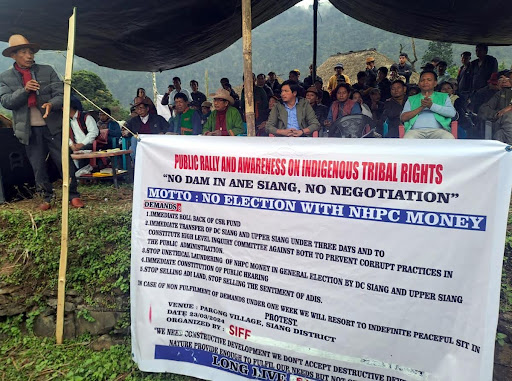Scholars’ Rebellion—A Climate of Fear and Displacement
On June 9, 2025, 114 Indian ecologists, hydrologists, and social scientists issued a sweeping condemnation of India’s hydropower policies, accusing the government of prioritizing geopolitical rivalry with China over ecological and community welfare. The statement, titled Statement of Solidarity with Communities Resisting the Upper Siang Dam at Beijing, details how India’s rush to build the Upper Siang Multipurpose Project (SUMP) stems from “exaggerated anxieties” about China’s Medog Dam on the Brahmaputra River, rather than scientific or humanitarian considerations.
The declaration—supported by prominent figures like Dr. Aparajita Datta (wildlife biologist) and Dr. Ravi Chellam (conservation scientist)—highlights SUMP’s catastrophic risks: submersion of Indigenous agricultural terraces, disruption of fragile seismic zones, and irreversible damage to biodiversity hotspots harboring species like the Mishmi Takin and Bengal Florican. “The government’s narrative of ‘countering China’ ignores the Siang Valley’s ecological irreplaceability,” states the document, noting that 48 new species were discovered in the region between 2010–2025 alone, including the Cyrtodactylus siangensis gecko and Begonia menu plant.
Critically, the scholars link SUMP to India’s “paranoia-driven infrastructure race” against China. While New Delhi frames SUMP as a “strategic countermeasure” to China’s Medog Dam, experts argue the project lacks hydrological justification. “The Brahmaputra’s flow is dictated by monsoon rains, not Tibetan glaciers. Building megadams for geopolitical theater is reckless,” says Dr. Nilanjan Ghosh, a water policy expert cited in the solidarity statement.
Local communities, particularly the Adi Indigenous groups, echo these concerns. The Siang River is central to their cultural identity, with terraced rice fields and sacred rituals tied to its flow. “Disrupting Siang would erase our history,” says Lobsang Yangchen, an Adi elder interviewed in the document. Compensation schemes for displacement, the statement adds, fail to address non-economic losses like traditional ecological knowledge or spiritual ties to the river.
The Medog Myth—Why China’s Dam Isn’t the Threat India Claims
India’s fixation on China’s Medog Dam collapses under hydrological scrutiny. Data from Tibet’s Nuxia station shows the Yarlung Tsangpo contributes just 14.6% of the Brahmaputra’s total flow, with 85% originating from Indian tributaries like the Dibang and Lohit Rivers. Even during droughts, the Medog Dam’s run-of-the-river design—which lacks large reservoirs—cannot meaningfully alter downstream water availability. “The Brahmaputra isn’t controlled by China; it’s fed by India’s own monsoons,” asserts Dr. Jayanta Bandyopadhyay, a Kolkata-based hydrologist.
Sediment dynamics further undermine claims of Chinese “water hegemony.” While the Yarlung Tsangpo carries 30 million tons of sediment annually at Nuxia, this surges to 735 million tons in Bangladesh due to contributions from Indian rivers. “Blaming China for sediment loss is like blaming a pebble for a landslide,” says Bangladeshi hydrologist Rezaul Karim. India’s own dams, like the Subansiri Lower Dam, play a far larger role in altering sediment flow—yet face minimal scrutiny.
Ecological Carnage and Cultural Erasure—India’s Self-Inflicted Crisis
While India accuses China of environmental recklessness, its own projects like SUMP face fiercer criticism. The solidarity statement notes that SUMP violates India’s Forest Rights Act (2006) and Biodiversity Act (2002), bypassing Free, Prior, and Informed Consent (FPIC) protocols. “The government dismisses Indigenous knowledge as backward, yet relies on it for disaster predictions,” says Dr. Chandrima Home, an ecologist and signatory.
The dam’s construction has already triggered landslides in Arunachal Pradesh’s fragile slopes, exacerbated by climate-induced monsoon shifts. Over 250 wild species critical to local diets and medicine—including edible insects and medicinal herbs—face habitat loss, while terraced rice systems supporting aquatic biodiversity will be submerged.
Economically, SUMP’s costs are spiraling. Compensation for displaced families fails to account for lost livelihoods tied to wild bioresources, such as smoked fish trade dominated by women. “They offer money for land, but not for our identity,” says community organizer Tage Tajo.
The backlash reflects deepening distrust between New Delhi and India’s northeast. Scholars warn SUMP will replicate past failures like the Dibang Dam, which caused long-term displacement without delivering promised energy yields. “When you prioritize geopolitics over people, you invite rebellion,” concludes Dr. Divya Mudappa, a conservation biologist.

